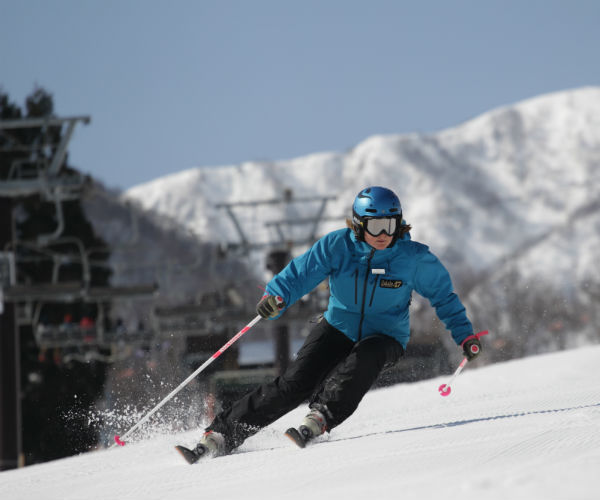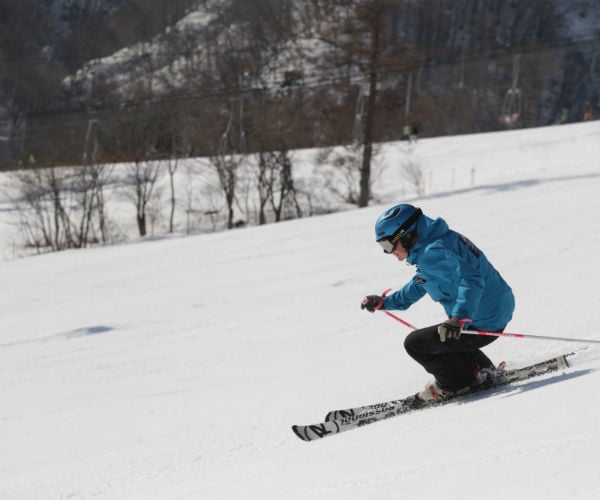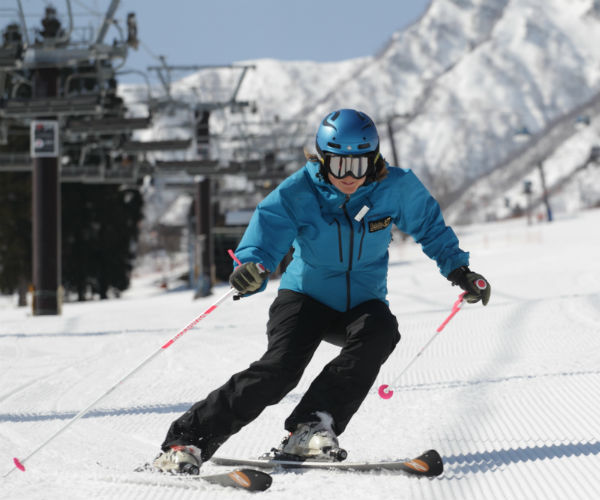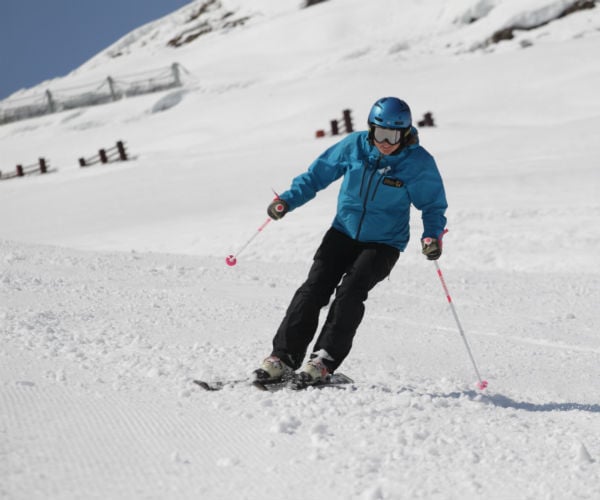The most common bad ski habits and how to correct them
Whether brand new to the sport or a seasoned skier, you likely will have heard about ski technique. Perhaps the biggest question relating to it; `is having good technique important?`. And the answer? Absolutely. People having different motivating factors for fine tuning their skiing, whether it is for vanity reasons – namely `looking good`, or wanting to tackle tricker terrain, but the most relevant reason to be technically sound when you ski is that it is the most efficient. When we have poor habits, they work against us, requiring us to use unnecessary energy and effort getting down, and can even place stress on body parts that need not be stressed. That said, here are three commonly seen bad habits in skiers of all levels, and more importantly, how to correct them.
 1. Leaning back
If you have ever taken a ski lesson in your life, you would have heard this. Don’t lean back. The temptation is very real, especially when apprehensive about the slope below or not confident in our ability. The instinct is to lean back, away from the offending slope, and closer to the snow. While it feels like there is logic in this – because let’s face it, when you’re nervous the last thing you feel like doing is leaning down the hill – it will create problems for us and will limit the ability to which we can ever ski to. When our weight is on our heels, our entire centre of mass is further back making it much harder to steer and have full control over our skis. We are also in a much more vulnerable position as the slightest bump could throw us off balance, and with our centre of mass already behind us we are not in a strong position to recover it. Instead, we want to be centred on our skis – which should be a hip width apart – and have a flex in our ankles, knees and hips. You can place your ski pole vertically at the front of your binding and it should meet your shoulder. As you ski downhill, feeling contact between your shins and ski boots is a good indicator that you’re on the right track. You should not feel the weight on your heels, nor should your calves be excessively achy or fatigued.
1. Leaning back
If you have ever taken a ski lesson in your life, you would have heard this. Don’t lean back. The temptation is very real, especially when apprehensive about the slope below or not confident in our ability. The instinct is to lean back, away from the offending slope, and closer to the snow. While it feels like there is logic in this – because let’s face it, when you’re nervous the last thing you feel like doing is leaning down the hill – it will create problems for us and will limit the ability to which we can ever ski to. When our weight is on our heels, our entire centre of mass is further back making it much harder to steer and have full control over our skis. We are also in a much more vulnerable position as the slightest bump could throw us off balance, and with our centre of mass already behind us we are not in a strong position to recover it. Instead, we want to be centred on our skis – which should be a hip width apart – and have a flex in our ankles, knees and hips. You can place your ski pole vertically at the front of your binding and it should meet your shoulder. As you ski downhill, feeling contact between your shins and ski boots is a good indicator that you’re on the right track. You should not feel the weight on your heels, nor should your calves be excessively achy or fatigued.
 2. Turning with the upper body
Turning with our upper body is another commonly seen bad habit amongst skiers of all levels. Though it feels like it might make sense to use our body to achieve our turns – by using our weight and throwing it into the direction we’re heading – in reality it doesn’t. Again, we make more work for ourselves as our balance will be continuously challenged and each turn will feel wobbly and unstable. This instability will also make it harder for our legs to do their job, causing them to tire faster or ache. Instead, think of yourself divided in two; your upper body being everything above the hips, and the lower body being everything from the hips downwards. We need to keep our upper body as quiet and balanced as possible whilst relying on our lower body to steer and pivot – being the primary turning effort. One way to achieve this is to pretend you`re carrying a tray of champagne with the goal being not to spill it, and allow the legs to do the bulk of the work as they turn underneath you.
2. Turning with the upper body
Turning with our upper body is another commonly seen bad habit amongst skiers of all levels. Though it feels like it might make sense to use our body to achieve our turns – by using our weight and throwing it into the direction we’re heading – in reality it doesn’t. Again, we make more work for ourselves as our balance will be continuously challenged and each turn will feel wobbly and unstable. This instability will also make it harder for our legs to do their job, causing them to tire faster or ache. Instead, think of yourself divided in two; your upper body being everything above the hips, and the lower body being everything from the hips downwards. We need to keep our upper body as quiet and balanced as possible whilst relying on our lower body to steer and pivot – being the primary turning effort. One way to achieve this is to pretend you`re carrying a tray of champagne with the goal being not to spill it, and allow the legs to do the bulk of the work as they turn underneath you.
 3. No flexion and extension
Another common pitfall is having no vertical movement throughout our turns. When we do not flex and extend our lower body throughout our turns, it makes it harder to achieve parallel at a lower level, or tackle bumpy, variable, powdered or steep terrain at a higher level. Extending upwards at the beginning of our turns makes it easier to do the turn itself as we momentarily unweight our skis. As we travel through the turn we begin to flex our knees, ankles and hips progressively until we are lowest to the snow by the end of the turn. This vertical movement – once correctly introduced into our skiing – should always be present, as a smooth but continuous movement. It is not uncommon to see seasoned skiers missing this from their skiing, and will therefore plateau in their ability and find themselves expending much more energy than needed. This is something that will require practise to get the timing correct, and focus to keep the movements going. With mileage it will soon become instinctive with every turn.
3. No flexion and extension
Another common pitfall is having no vertical movement throughout our turns. When we do not flex and extend our lower body throughout our turns, it makes it harder to achieve parallel at a lower level, or tackle bumpy, variable, powdered or steep terrain at a higher level. Extending upwards at the beginning of our turns makes it easier to do the turn itself as we momentarily unweight our skis. As we travel through the turn we begin to flex our knees, ankles and hips progressively until we are lowest to the snow by the end of the turn. This vertical movement – once correctly introduced into our skiing – should always be present, as a smooth but continuous movement. It is not uncommon to see seasoned skiers missing this from their skiing, and will therefore plateau in their ability and find themselves expending much more energy than needed. This is something that will require practise to get the timing correct, and focus to keep the movements going. With mileage it will soon become instinctive with every turn.
 Technique is designed to be the most efficient way to ski. It will give us confidence as we begin to feel more stable and smooth. Though these tips can certainly give us food for thought and ideas to try on the snow, the best thing for anyone serious about improving their technique is to hire a professional ski instructor. With an understanding of how you personally learn best, they can explain, demonstrate, watch and correct your skiing, even providing exercises to force necessary movements – in a safe and fun environment.
Nadine Robb is Owner and Instructor at Hakuba Ski Concierge. Hakuba Ski Concierge is a boutique ski school in Hakuba, Japan.
If you would like to be a guest blogger on A Luxury Travel Blog in order to raise your profile, please contact us.
Technique is designed to be the most efficient way to ski. It will give us confidence as we begin to feel more stable and smooth. Though these tips can certainly give us food for thought and ideas to try on the snow, the best thing for anyone serious about improving their technique is to hire a professional ski instructor. With an understanding of how you personally learn best, they can explain, demonstrate, watch and correct your skiing, even providing exercises to force necessary movements – in a safe and fun environment.
Nadine Robb is Owner and Instructor at Hakuba Ski Concierge. Hakuba Ski Concierge is a boutique ski school in Hakuba, Japan.
If you would like to be a guest blogger on A Luxury Travel Blog in order to raise your profile, please contact us.
 1. Leaning back
If you have ever taken a ski lesson in your life, you would have heard this. Don’t lean back. The temptation is very real, especially when apprehensive about the slope below or not confident in our ability. The instinct is to lean back, away from the offending slope, and closer to the snow. While it feels like there is logic in this – because let’s face it, when you’re nervous the last thing you feel like doing is leaning down the hill – it will create problems for us and will limit the ability to which we can ever ski to. When our weight is on our heels, our entire centre of mass is further back making it much harder to steer and have full control over our skis. We are also in a much more vulnerable position as the slightest bump could throw us off balance, and with our centre of mass already behind us we are not in a strong position to recover it. Instead, we want to be centred on our skis – which should be a hip width apart – and have a flex in our ankles, knees and hips. You can place your ski pole vertically at the front of your binding and it should meet your shoulder. As you ski downhill, feeling contact between your shins and ski boots is a good indicator that you’re on the right track. You should not feel the weight on your heels, nor should your calves be excessively achy or fatigued.
1. Leaning back
If you have ever taken a ski lesson in your life, you would have heard this. Don’t lean back. The temptation is very real, especially when apprehensive about the slope below or not confident in our ability. The instinct is to lean back, away from the offending slope, and closer to the snow. While it feels like there is logic in this – because let’s face it, when you’re nervous the last thing you feel like doing is leaning down the hill – it will create problems for us and will limit the ability to which we can ever ski to. When our weight is on our heels, our entire centre of mass is further back making it much harder to steer and have full control over our skis. We are also in a much more vulnerable position as the slightest bump could throw us off balance, and with our centre of mass already behind us we are not in a strong position to recover it. Instead, we want to be centred on our skis – which should be a hip width apart – and have a flex in our ankles, knees and hips. You can place your ski pole vertically at the front of your binding and it should meet your shoulder. As you ski downhill, feeling contact between your shins and ski boots is a good indicator that you’re on the right track. You should not feel the weight on your heels, nor should your calves be excessively achy or fatigued.
 2. Turning with the upper body
Turning with our upper body is another commonly seen bad habit amongst skiers of all levels. Though it feels like it might make sense to use our body to achieve our turns – by using our weight and throwing it into the direction we’re heading – in reality it doesn’t. Again, we make more work for ourselves as our balance will be continuously challenged and each turn will feel wobbly and unstable. This instability will also make it harder for our legs to do their job, causing them to tire faster or ache. Instead, think of yourself divided in two; your upper body being everything above the hips, and the lower body being everything from the hips downwards. We need to keep our upper body as quiet and balanced as possible whilst relying on our lower body to steer and pivot – being the primary turning effort. One way to achieve this is to pretend you`re carrying a tray of champagne with the goal being not to spill it, and allow the legs to do the bulk of the work as they turn underneath you.
2. Turning with the upper body
Turning with our upper body is another commonly seen bad habit amongst skiers of all levels. Though it feels like it might make sense to use our body to achieve our turns – by using our weight and throwing it into the direction we’re heading – in reality it doesn’t. Again, we make more work for ourselves as our balance will be continuously challenged and each turn will feel wobbly and unstable. This instability will also make it harder for our legs to do their job, causing them to tire faster or ache. Instead, think of yourself divided in two; your upper body being everything above the hips, and the lower body being everything from the hips downwards. We need to keep our upper body as quiet and balanced as possible whilst relying on our lower body to steer and pivot – being the primary turning effort. One way to achieve this is to pretend you`re carrying a tray of champagne with the goal being not to spill it, and allow the legs to do the bulk of the work as they turn underneath you.
 3. No flexion and extension
Another common pitfall is having no vertical movement throughout our turns. When we do not flex and extend our lower body throughout our turns, it makes it harder to achieve parallel at a lower level, or tackle bumpy, variable, powdered or steep terrain at a higher level. Extending upwards at the beginning of our turns makes it easier to do the turn itself as we momentarily unweight our skis. As we travel through the turn we begin to flex our knees, ankles and hips progressively until we are lowest to the snow by the end of the turn. This vertical movement – once correctly introduced into our skiing – should always be present, as a smooth but continuous movement. It is not uncommon to see seasoned skiers missing this from their skiing, and will therefore plateau in their ability and find themselves expending much more energy than needed. This is something that will require practise to get the timing correct, and focus to keep the movements going. With mileage it will soon become instinctive with every turn.
3. No flexion and extension
Another common pitfall is having no vertical movement throughout our turns. When we do not flex and extend our lower body throughout our turns, it makes it harder to achieve parallel at a lower level, or tackle bumpy, variable, powdered or steep terrain at a higher level. Extending upwards at the beginning of our turns makes it easier to do the turn itself as we momentarily unweight our skis. As we travel through the turn we begin to flex our knees, ankles and hips progressively until we are lowest to the snow by the end of the turn. This vertical movement – once correctly introduced into our skiing – should always be present, as a smooth but continuous movement. It is not uncommon to see seasoned skiers missing this from their skiing, and will therefore plateau in their ability and find themselves expending much more energy than needed. This is something that will require practise to get the timing correct, and focus to keep the movements going. With mileage it will soon become instinctive with every turn.
 Technique is designed to be the most efficient way to ski. It will give us confidence as we begin to feel more stable and smooth. Though these tips can certainly give us food for thought and ideas to try on the snow, the best thing for anyone serious about improving their technique is to hire a professional ski instructor. With an understanding of how you personally learn best, they can explain, demonstrate, watch and correct your skiing, even providing exercises to force necessary movements – in a safe and fun environment.
Nadine Robb is Owner and Instructor at Hakuba Ski Concierge. Hakuba Ski Concierge is a boutique ski school in Hakuba, Japan.
If you would like to be a guest blogger on A Luxury Travel Blog in order to raise your profile, please contact us.
Technique is designed to be the most efficient way to ski. It will give us confidence as we begin to feel more stable and smooth. Though these tips can certainly give us food for thought and ideas to try on the snow, the best thing for anyone serious about improving their technique is to hire a professional ski instructor. With an understanding of how you personally learn best, they can explain, demonstrate, watch and correct your skiing, even providing exercises to force necessary movements – in a safe and fun environment.
Nadine Robb is Owner and Instructor at Hakuba Ski Concierge. Hakuba Ski Concierge is a boutique ski school in Hakuba, Japan.
If you would like to be a guest blogger on A Luxury Travel Blog in order to raise your profile, please contact us.Did you enjoy this article?
Receive similar content direct to your inbox.


I’m a terrible skier and guilty of all three of these. But I suspect my worst failing is a tendency to lean back. As you say, it’s instinctive and I find that hard to break sometimes. I know I’m not meant to do it, but often that instinct seems to overrule the brain! I think I’m also worse with this issue on a dry ski slope where I’m less confident and perhaps more fearful of falling…
I do believe that leaning back is THE most common ski error, and one that is seen at almost every level. Even very proficient skiers get caught `being in the backseat` in the powder snow or even moguls. For the dry slope, that is one of the draw backs in that falling can be more uncomfortable than soft snow. Trying little hops or jumps between turns is one way to centre you; it is almost impossible to both take off and land if your weight is on your heels, so that is a good exercise to combat leaning back. At a very beginner level, doing a run without your poles and keeping your hands on your knees will also bring you into a more neutral stance. All the best…!
Thank you… and yes, I’m at ‘very beginner level’ (or at least it feels like it!). I have been told to do what you say before and I think it helps – I just don’t feel I’m progressing, but then I started very late and sadly probably don’t ski nearly often enough to ever really improve…
Fortunately Paul vast improvement is possible at almost any age and frequency; I would love to give you a ski lesson in Hakuba, Japan, if you are able to make it over here one winter!
Thank you, Nadine… if I ever make it over, I will let you know! I’m sure I can’t get any worse!!! :-)
There’s a lot of truth in here. I feel a bit guilty reading this. Certainly I was a bit of a poseur on the slopes in my younger days and paid the price for it.
I think we have all been guilty of that one Ed….!!
I think these are really important things to consider, especially if you haven’t necessarily been taught the best habits or methods so you may not realise the potential dangers or limitations in what you’re doing. I know a few people who ski and I’ve heard a few horror stories about what seem to be quite common injuries, most of which are caused by bad habits like these. Correcting them obviously not only reduces the risk of accidents and injuries but saves energy in some case, like where number 3 comes into it if you’re not flexing properly, and makes for smoother, more effective skiing.
Great point Elaine, thank you! Absolutely, having good technique does massively minimise the risk of injury and will keep us safer on the slopes; it is probably the best step we can take to avoid ski injuries.